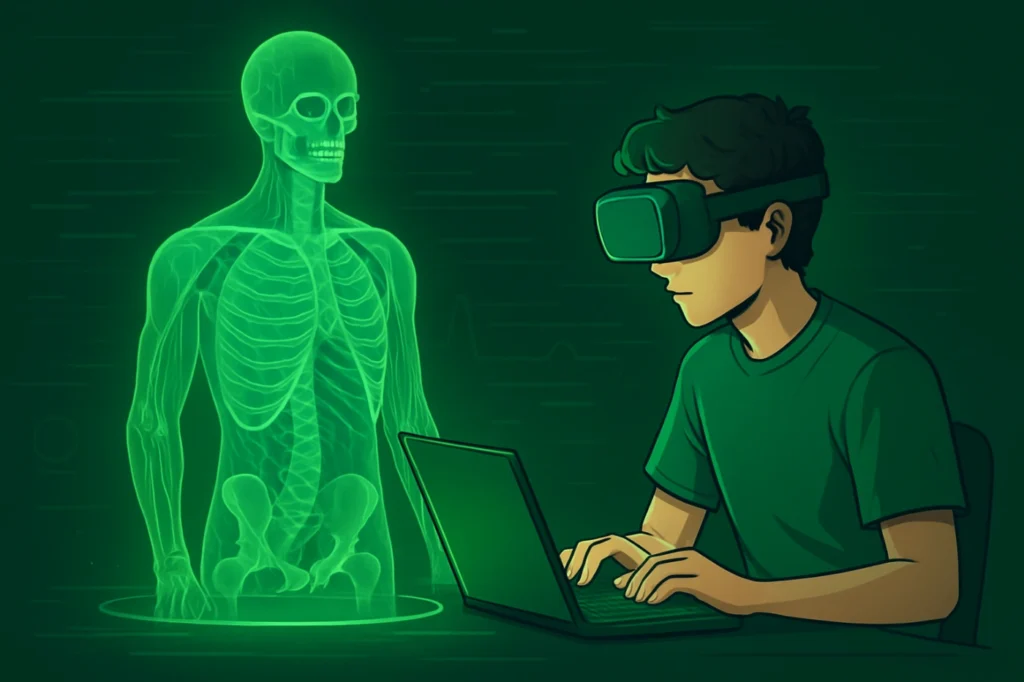Virtual reality (VR) is revolutionizing education, particularly in the field of anatomy. It offers a dynamic and immersive learning experience that surpasses traditional methods. This document explores how VR transforms anatomy learning for students, focusing on interactive 3D models, enhanced spatial understanding, surgical simulations, and the benefits for neurodivergent learners.
Exploring Interactive 3D Models in Virtual Reality
Virtual reality (VR) is changing how students learn anatomy. Traditional methods often rely on static images or 2D diagrams. These can be limiting. VR offers a dynamic, interactive experience. You can explore 3D models of the human body. This provides a deeper understanding of anatomical structures.
- Immersive Exploration:
- VR allows you to virtually walk through the human body.
- You can examine organs and tissues from any angle.
- This level of immersion enhances spatial understanding.
- Detailed Visualization:
- VR models are incredibly detailed.
- You can see intricate anatomical structures up close.
- This helps you grasp complex relationships between different body parts.
- Interactive Learning:
- VR platforms often include interactive features.
- You can dissect virtual organs or manipulate anatomical structures.
- This active engagement reinforces anatomy learning.
Enhancing Spatial Understanding of Complex Anatomical Structures
Understanding spatial relationships is crucial in anatomy learning. Traditional methods can fall short. VR excels in this area. It allows you to visualize and manipulate complex structures in 3D space. This leads to a more intuitive grasp of anatomy.
- Visualizing Depth and Dimension:
- VR eliminates the limitations of 2D images.
- You can see the depth and dimension of anatomical structures.
- This is particularly helpful for understanding complex organs.
- Rotating and Manipulating Models:
- VR allows you to rotate and manipulate 3D models.
- You can examine structures from any perspective.
- This helps you understand their spatial relationships.
- Understanding Layered Structures:
- The human body is made up of many layers.
- VR can show you how these layers interact.
- You can peel away layers to see deeper structures. This is a powerful tool for anatomy learning.
Simulating Surgical Procedures for Practical Experience
VR offers a safe and realistic environment for surgical training. Medical students can practice procedures without risk. This is a significant advantage over traditional methods. VR simulations provide valuable practical experience.
- Realistic Simulation:
- VR simulations mimic real-life surgical scenarios.
- You can practice procedures with realistic tools and environments.
- This prepares students for actual surgeries.
- Error-Free Practice:
- VR allows you to make mistakes without consequences.
- You can learn from errors in a safe environment.
- This helps you develop confidence and proficiency.
- Repetitive Training:
- Practice makes perfect.
- VR allows for repetitive training of complex procedures.
- This reinforces skills and improves performance. You can enhance your anatomy learning in this way.
The benefits of VR anatomy learning for neurodivergent students.
VR presents unique advantages for neurodivergent students in anatomy learning. Traditional learning methods may not address their specific needs. VR provides a customizable and engaging environment. This can improve learning outcomes.
- Personalized Learning:
- Neurodivergent students often benefit from personalized learning.
- VR allows for customizable learning experiences.
- You can adjust the pace and complexity of the content.
- Reduced Distractions:
- VR can minimize distractions and create a focused environment.
- This is especially helpful for students with attention challenges.
- You can immerse yourself in the learning experience.
- Enhanced Visual Learning:
- Many neurodivergent students are visual learners.
- VR provides highly visual and interactive content.
- This can make anatomy learning more accessible and engaging. VR helps with anatomy learning in many ways.

